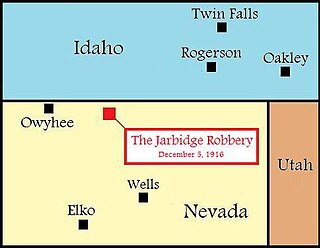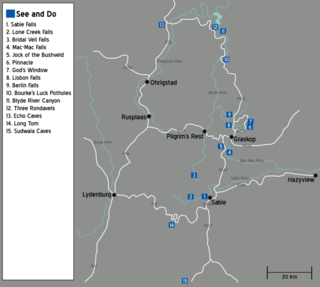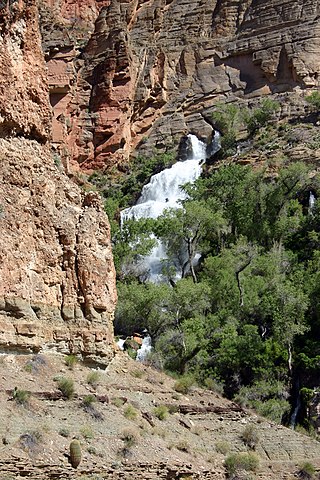
Letchworth State Park is a 14,427-acre (5,838 ha) New York State Park located in Livingston County and Wyoming County in the western part of the State of New York. The park is roughly 17 miles (27 km) long, following the course of the Genesee River as it flows north through a deep gorge and over several large waterfalls. It is located 35 miles (56 km) southwest of Rochester and 60 miles (97 km) southeast of Buffalo, and spans portions of the Livingston County towns of Leicester, Mount Morris and Portage, as well as the Wyoming County towns of Castile and Genesee Falls.

Mackenna's Gold is a 1969 American Western film directed by J. Lee Thompson, starring an ensemble cast featuring Gregory Peck, Omar Sharif, Telly Savalas, Ted Cassidy, Camilla Sparv and Julie Newmar in lead roles. It was photographed in Super Panavision 70 and Technicolor by Joseph MacDonald, with original music by Quincy Jones.

Superstition Mountain is a prominent mountain and regional landmark located in the Phoenix metropolitan area of Arizona, immediately east of Apache Junction and north of Gold Canyon. It anchors the west end of the Superstition Mountains and is a popular outdoor recreation destination, home to numerous trails for hiking and horseback riding. The legend of the Lost Dutchman's Gold Mine centers around the mountain.

Pirate Islands is an Australian children's television program screened on Network Ten in 2003. A sequel called The Lost Treasure of Fiji premiered on Network Ten in 2007.

The Superstition Mountains is a range of mountains in Arizona located to the east of the Phoenix metropolitan area. They are anchored by Superstition Mountain, a large mountain that is a popular recreation destination for residents of the Phoenix, Arizona, area. They are roughly bounded by U.S. Route 60 on the south, Arizona State Route 88 on the northwest, and Arizona State Route 188 on the northeast.

The Tanner Trail is a hiking trail located on the South Rim of the Grand Canyon National Park, located in the U.S. state of Arizona. The trailhead is located at Lipan Point, a prominent lookout located to the east of the Grand Canyon Village, and the trail ends at the Colorado River at Tanner Rapids.

The treasure of Loch Arkaig, sometimes known as the Jacobite gold, was a large amount of specie provided by Spain to finance the Jacobite rising in Scotland in 1745, and rumoured still to be hidden at Loch Arkaig in Lochaber.
The Lost Adams Diggings is a Southwestern treasure story that refers to the existence of a canyon rich in gold deposits somewhere in western New Mexico in the early 1860s.
The Lost Ship of the Desert is the subject of legends about various historical maritime vessels having supposedly become stranded and subsequently lost in the deserts of the American Southwest, most commonly in California's Colorado Desert. Since the period following the American Civil War, stories about Spanish treasure galleons buried beneath the desert sands north of the Gulf of California have emerged as popular legends in American folklore.

Two Guns is a ghost town in Coconino County, Arizona, United States. Located on the east rim of Canyon Diablo about 30 mi (48 km) east of Flagstaff, Two Guns prospered as a tourist stop along Route 66.

Outlaw Trail: The Treasure of Butch Cassidy is a 2006 American adventure film, produced and directed by Ryan Little. It is loosely based on legends arising from the fate of real-life Western outlaw Butch Cassidy, the alias of Robert LeRoy Parker, whose gang robbed trains and banks in the 1890s. Cassidy fled to South America in 1901, where he is believed to have died in 1908.

North Table Mountain and South Table Mountain are two prominent basaltic mesas overlooking the city of Oroville, California. They lie a few miles north of Oroville in Butte County, California. In the scientific literature, both mesas are also known as North Oroville Table Mountain and South Oroville Table Mountain in order to differentiate them from the TuolumneTable Mountain, which is also capped by the eroded remnant of a basaltic lava flow, in the central foothills of California. They are named for their flat surface, like a table top; because of this it is often mistakenly called Table Top Mountain.

Havasu Creek is a stream in the U.S. state of Arizona associated with the Havasupai people. It is a tributary to the Colorado River, which it enters in the Grand Canyon.

The Battleground Gunfight, also known as the Battleground Shootout, was a gunfight between a posse of American lawmen and the Smith Gang. It was fought on October 8, 1901, within Arizona Territory's Fort Apache Indian Reservation, at a clearing in the forest known today as the "Battleground". Nine Arizona Rangers and deputies caught up with the cattle rustler Bill Smith and his gang. During a long exchange of gunfire that followed, Ranger Carlos Tafolla and Deputy Bill Maxwell were killed and one or two of the outlaws may have been wounded. In the end, the Smith Gang escaped the posse and fled into Mexico.
Gold Trails and Ghost Towns is a Canadian historical documentary show, created and produced by television station CHBC-TV in Kelowna, British Columbia for Canadian syndication and hosted by Mike Roberts with historian/storyteller Bill Barlee. The show was filmed in a studio which resembled an old trapper's cabin. Mike and Bill discussed prospectors and the history of British Columbia around 1900.

The Jarbidge Stage Robbery was the last stage robbery in the Old West. On December 5, 1916, the driver of a small two-horse mail wagon was ambushed as he was riding to the town of Jarbidge, Nevada. The driver was killed and $4,000 was stolen, however, three suspects were arrested shortly afterward, including a horse thief named Ben Kuhl. Kuhl would eventually become the first murderer in American history to be convicted and sent to prison by the use of palm print evidence. The stolen $4,000 was never recovered and is said to be buried somewhere in Jarbidge Canyon. According to author Ken Weinman, the Jarbidge Stage Robbery is one of the "best authenticated buried treasure stories in Nevada's long history."

The Power's Cabin shootout, or the Power Brothers shootout, occurred on February 10, 1918, when a posse attempted to arrest a group of miners at their cabin in the Galiuro Mountains. Four men were killed during the shootout, including three lawmen and Jeff Power, the owner of the cabin. The Power brothers, Tom and John, then escaped to Mexico with a man named Tom Sisson, but they were eventually caught after what was then the largest manhunt in the history of Arizona.

The Fenn Treasure was a cache of gold and jewels that Forrest Fenn, an art dealer and author from Santa Fe, New Mexico, hid in the Rocky Mountains of the United States. It was found approximately a decade later in 2020 in Wyoming by an anonymous treasure hunter later revealed to be former journalist and medical student Jack Stuef. In attempting to honor what he perceives to be Fenn's wishes after his death in September 2020, he has refused to reveal the location of the treasure. An auction of items from the treasure chest in December of 2022 resulted in $1.3 million in sales.

The Panorama Route is a scenic road in South Africa connecting several cultural and natural points of interest. The route, steeped in the history of South Africa, is in Mpumalanga province, centred around the Blyde River Canyon, the world's third largest canyon. It features numerous waterfalls, one of the largest afforested areas in South Africa, and several natural landmarks. The route starts at the foot of the Long Tom Pass just outside Lydenburg, following the natural descent from the Great Escarpment to the Lowveld, and ending at the border of the Mpumalanga and Limpopo provinces near the Echo Caves.

Thunder River is a river entirely within the Grand Canyon National Park. It flows southeast from its source near the North Rim of the canyon to Tapeats Creek. The 0.5-mile-long (0.80 km) river is one of the shortest in the United States, and drops approximately 1,200 feet (370 m) over a series of waterfalls, making it the steepest river in the country. It is also a rare instance where a river is a tributary of a creek.

















